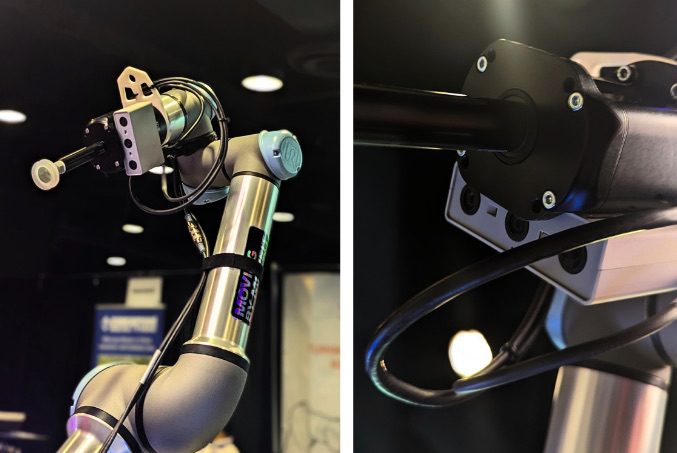TL;DR:
- Tangram Vision, a pioneer in perception and sensor technology, introduces HiFi, a groundbreaking 3D depth sensor.
- HiFi combines impressive hardware, AI capabilities, and software tools, simplifying robotic perception for engineers.
- Tangram’s successful Kickstarter campaign for HiFi signals strong industry demand for enhanced 3D sensing solutions.
- The company’s agile approach positions it as a reliable player in the dynamic depth sensor market.
Main AI News:
In the rapidly evolving landscape of robotics and artificial intelligence, Tangram Vision emerges as a beacon of innovation. With over 60 years of combined expertise in perception and sensor technology, this Boulder, Colorado-based startup is rewriting the rules of the game. Established in 2020, Tangram Vision has honed its prowess in tackling complex perception challenges, including multimodal sensor calibration, sensor fusion, and sensor uptime. Now, it’s poised to disrupt the market with its groundbreaking 3D depth sensor, HiFi, infused with potent AI capabilities.
HiFi, Tangram’s latest creation, has taken the world by storm since its launch on Kickstarter. Early backers have the exclusive opportunity to acquire HiFi for just $349, a substantial 36% discount from the $549 retail price. Remarkably, the campaign achieved its $25,000 goal within a mere four hours of launch, and as of press time, the campaign has garnered over $40,000 in support. Tangram is committed to delivering the first HiFi units in April 2024, setting a new standard for robotic perception hardware.
The roots of Tangram Vision trace back to Occipital, the trailblazing spatial computing company that introduced the Structure Sensor 3D sensor through a remarkable $1.3 million Kickstarter campaign in 2013. Brandon Minor, CEO of Tangram Vision, emphasizes the significance of their venture, stating, “Tools for robotics and AI have come a long way in the past few years, but sensors haven’t kept pace. After speaking with hundreds of robotics and AI engineers, we knew they wanted to spend less time struggling with sensors and more time building cool products. HiFi makes it dead simple to add AI-enhanced 3D data to robots and more.”
Elevating Robotic Perception with HiFi
HiFi leverages ams Mira220 cameras, merging a 136° field of view 2-megapixel global shutter IR stereo pair with a 136° field of view 2-megapixel RGB camera and dual active projectors. With a 65mm baseline, HiFi delivers depth ranging from 0.3m to 5m at a remarkable 30-60 frames per second. Tangram’s ingenuity shines as HiFi’s expansive field of view enables roboticists to replace two depth sensors with a single HiFi in numerous applications.
But HiFi is more than just hardware; it’s a comprehensive solution for roboticists. It seamlessly integrates with ROS 2 and boasts an impressive 8 TOPS of machine learning processing power, facilitating on-sensor fusion of AI and 3D data. Additionally, HiFi is equipped with 8GB of onboard memory, enabling the execution of neural networks directly on the sensor. The inclusion of a dedicated depth processor on the Texas Instruments (TI) Jacinto chip ensures compatibility with TI’s Deep Learning Library, complete with deployable models for scene segmentation, pose estimation, object identification, object tracking, and more. Tangram enhances the package with sensor software tools, including self-calibration, time synchronization, and uptime management.
A Response to Industry Demand
Tangram’s foray into developing a 3D sensor was a response to the overwhelming demand expressed by its robotics customers. Brandon Minor elaborates, “Right now, robotics engineers must choose between 3D data quality, AI capabilities, or reliability. But they really want all three.” This sentiment resonates with the words of Nathan Brooks, CTO of PickNik, who shared, “We’ve been talking with Tangram for years and sharing some of our pains in deploying robotic applications in the real world and unstructured environments.” HiFi addresses these concerns and opens up new possibilities for Tangram to collaborate with different types of robots and applications, including industrial automation.
Seizing the Market Opportunity
To comprehend the potential that HiFi represents, one must consider the tumultuous history of the depth sensor market. Formerly strong contenders like Kinect and Project Tango faced uncertain futures, and even Intel’s RealSense division encountered adversity. Tangram Vision may not possess the scale of these industry giants, but Brandon Minor sees this as an advantage, stating, “I don’t know if folks trust those larger players. There’s risk there as well. We don’t have as many mouths to feed, and this could be game-changing for the industry and our company.” Moreover, the introduction of HiFi presents Tangram with an opportunity to introduce its calibration services and recurring revenue model to new audiences, reinforcing its mission to lower the barrier to entry into computer vision.
Conclusion:
Tangram Vision’s HiFi 3D sensor marks a significant step forward in the world of robotics, offering a holistic solution that addresses engineers’ demands for superior 3D data quality, AI integration, and reliability. The overwhelmingly positive response to the HiFi Kickstarter campaign underscores the market’s hunger for such innovations. Tangram’s flexibility and focus on customer needs position it favorably in a competitive depth sensor market, poised to drive advancements in robotics and AI applications.

